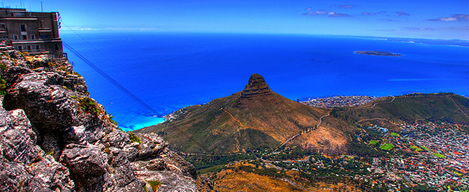Cape Town: Hiking and Walking Trails

Table Mountain National Park
Covering an area of 221 km², or some three quarters of the peninsular in four broadly separate zones, the park was established in May 1998 in order to protect the unique landscapes and ecology of the Table Mountain chain (Hoerikwaggo in the Koisan).
The Table Mountain Section of the park receives the vast majority of visitors. It is this area that covers the iconic feature of 1086m flat top Table Mountain itself, which is buttressed on either side by Signal Hill, Lions Head and Devil’s Peak. The summit of Table Mountain is accessible by foot trail or cable car, the latter offering a spectacular ride and superb views from the summit on arrival. The summit is not infrequently blanketed by a static cloud formation known as the tablecloth at which times it is pointless to make the journey. The best opportunities for clear weather are in the morning or evening.
The Silver Mine/Tokai Section sits midway down the length of the peninsular along the Atlantic seaboard, and along the east facing coast of False Bay. Along the western edge of the peninsular it looks down on Hout Bay, Chapman’s Peak and Noordhoek.
The Cape Point Section is the area at the extremity of the peninsular stretching from the Cape of Good Hope to Cape Point, and including Scarborough and Simon’s Town.
For hikers and climbers 300 separate routes up the mountain have been identified allowing for amble opportunity to get lost or run into trouble. A number of these are technical and others not, and although none are easy, some can be accomplished in a day, while others provide several different multi-day options. Three Hoerikwaggo Trails were launched in 2005 for the purpose of facilitating multi-day hikes from the City Bowl side of the park in the north to Cape Point.
It is advisable to seek advice from your lodge or hotel before setting out. The cableway tends not to operate during high winds or bad weather, but for general information log on to tablemountain.net or telephone 021 428 5148
For guided hikes and climbs contact Kabbo African Adventures or Venture Forth.
City & Surrounds Walks/Hikes
There are a variety of other options for recreational walks within the urban boundaries of Cape Town.
Signal Hill
Forming the north western Boundary of the City Bowl, Signal Hill is a promontory off Table Mountain that slopes in the direction of the Atlantic Ocean. It is a stiff walk to the top, but worth it for views of the city, and the Noon Gun, a cannon that is fired at noon, traditionally to allow the citizens of the city below to coordinate their time. To get there follow Longmarket Street through the Bo-Kaap until it meets a trail head.
Kirstenbosch Botanical Gardens
Situated on the east slopes of the Berg (Table Mountain), Kirstenbosch Botanical Garden is just another of the superbly appointed features of this city, that after a while one might be forgiven for finding tedious in the apparently endless repetition of sublimely beautiful places.
The Cape plant ecology is defined largely by the Fynbos phenomenon. The signature feature of Fynbos is the sheer diversity of associated plant life, and in particular of floral species. Meaning Fine Bush in the Afrikaans, Fynbos is essentially shrub or heath land, occurring mainly in those areas of the Cape that experience winter rainfall and that can be described as having a Mediterranean climate. The three main floral elements are Proteas, Ericas and Restios, the first being perhaps the most prominent, with many species, some commercially produced, and all with a unique, hard leafed structure and tubular flowers.
Kirtsenbosch is arguably the premier showcase of Cape flora, although of course the entire region is replete with public and private gardens that compete in glorious displays. It is extensive in its reach, providing a superb backdrop for a recreational stroll as well as those interested in the in depth study of local garden culture.
It almost goes without saying that this explosion of colour and vivacity attracts large numbers of local birds, some endemic, and many closely associate with the Fynbos landscapes. Coupled with this, summer evening concerts are held on the expansive lawns of the gardens from November until April.
An absolute must for the Cape Town visitor.
Lion’s Head
Between the Berg and Signal hill lies Lions head, although Lion’s Tooth might have been a better name for this abrupt peak rising almost directly out of the west of the city. It is a stiff 2.2km walk to the summit, but worth it, particularly on a full moon when a regular congregation of lunar freaks will greet you with a variety of herbal enhancements and some interesting celestial philosophies. Accessible via Kloof Nek, a road running between Lion’s Head and the Berg.
The Cape of Good Hope Trail
This is a two day one night trip that covers the 40km circular route through the reserve. It is necessary to book in advance for this one, usually through the Buffelsfontein Visitors Center on (021) 780 9204.
More Cape Town:
A Brief History Cultural Sites & Museums Beaches Golf Courses Health & Wellness Adrenalin Sports Festivals & Venues Food & Wine